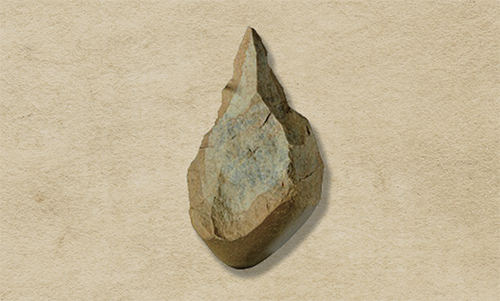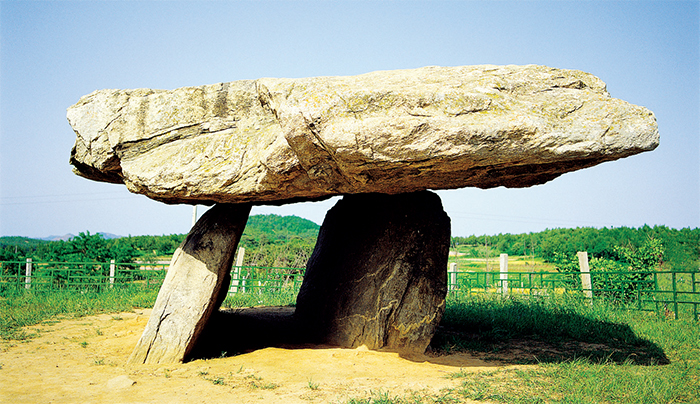
Comb-pattern Pottery.This object with a pointy bottom was discovered in Amsa-dong, Seoul, a representative historic site of the Neolithic Age.
The history of the Korean nation began in Manchuria and the Korean Peninsula when people started settling there 700,000 years ago. Representative historic sites associated with the people of the Paleolithic Age, who used tools made of animal horns and chipped stone tools, include Geomeunmoru Cave in Sangwon, Pyeongannam-do Province; Jeongok-ri in Yeoncheon, Gyeonggi-do Province; Seokjang-ri in Gongju, Chungcheongnam-do Province; and Durubong Cave in Cheongju, Chungcheongbuk-do Province. The early inhabitants of the peninsula survived by hunting for animals and collecting edible plants in groups.
In Korea, the Neolithic Age began around B.C.8,000. People started farming, cultivating cereals such as millet, and used polished stone tools. They started settling down permanently in places and formed clan societies. One of the most representative features of the Neolithic Age is combpatterned pottery, examples of which have been found all across the Korean Peninsula, including Amsa-dong, Seoul; Namgyeong, Pyeongyang; and Suga-ri, Gimhae.

Hand Axe.This multifunctional tool dates back to the Paleolithic period, it was discovered in Jeongok-ri, Yeoncheon-gun, Gyeonggi-do.
The Bronze Age started around the 10th century BC on the Korean Peninsula and the 15th century BC in Manchuria. Historic sites associated with the Bronze Age are found in Liaoning and Jilin Provinces, China and across the Korean Peninsula. With the development of the Bronze culture, a society emerged in which the head of a clan exercised great influence. The strongest clan leaders started merging many clans into one, and these groups very gradually developed into early states.
The tribes that played a central role in the establishment of Gojoseon, which emerged as the first recognizable state of the Korean people, believed in the King of Heaven and worshipped bears. The two factions jointly upheld Dangun Wanggeom as their chief priest and political leader. Gojoseon fostered an independent culture in Liaoning, China and along the Daedonggang River. By the 3rd century BC, kings such as King Bu and King Jun had become powerful and bequeathed the throne to their sons. They established a solid system of rule, backed by high-ranking retainers and military officers.
Towards the end of the 3rd century, the Qin Dynasty was replaced by the Han Dynasty in China, creating a period of social upheaval. Many people moved southward to Gojoseon. Their leader, Wiman, acceded to the throne in B.C. 194 and Gojoseon expanded its territory under his rule. By this time, Gojoseon had adopted iron culture, developed agriculture and various handicrafts, and increased its military strength. It tried to monopolize profit, while serving as an intermediate in the trade between the Korean Peninsula and China, taking advantage of its geographical proximity to China. This led to confrontation between Gojoseon and Han China. Han attacked Gojoseon with a large number of ground and naval forces. Gojoseon defiantly resisted the attack and won a great victory in the early stage of the war, but its capital at Wanggeomseong Fortress fell after a year of war, and Gojoseon collapsed in B.C. 108.

Table-type Dolmens in Bugeun-ri, Ganghwa

Dolmen Park in Suncheon, Jeollanam-do
Dolmen
The Seven Wonders of the World include sites such as the Great Pyramid of Giza, the Great Wall of China, and Stonehenge in England among others. However, Korea’s dolmens are no less mysterious. About half of all the dolmens in the world or around 40,000 dolmens are found on the Korea Peninsula.
Diverse artifacts, including human bones, stone objects, and jade and bronze artifacts, have been unearthed from the dolmens, although how such large stones were transported and built at that time still remains a mystery.
In the past, the dolmens in Korea used to be classified into two categories: the northern type (table type), which includes the dolmens located north of the Hangang River, and the southern type (go-table type). However, after go-table dolmens were found north of the Hangang River, and tabletype dolmens were found south of the river, the northern/southern-type appellations were dropped. Meanwhile, other scholars have added new types to this system of classification.
Dolmens are often referred to as tombs, but it is difficult to make this claim with any certainty. Yi Gyu-bo, a great scholar of Goryeo in the 12th century, left the following remarks about dolmens: “People say that the saints put the dolmens there in the olden days. It is indeed a wonderful technique (that enabled men to position such huge rocks in that way).”
In the early 20th century, American missionary Horace Grant Underwood claimed that dolmens were not tombs but rather that they were put there for sacrificial rituals offered to the gods of the earth. A Korean folklorist named Son Jin-tae pointed to a folktale in which dolmens were believed to be the houses of witches (Mago halmeoni in local legends).
Dolmens are rarely found in China, except for Manchuria, or Japan, yet many thousands of them can be seen across the Korean Peninsula. They were erected over many thousands of years, but this process stopped sometime before Christ. There are many unsolved mysteries surrounding the dolmens, such as the reason for their concentration in such great numbers on the Korean Peninsula in Northeast Asia and their connectivity with those found in Europe or India. UNESCO’s acceptance of the South Korean government’s application for registration of the dolmens in Ganghwa, Hwasun, and Gochang in 2000 as a world cultural heritage attests to the world’s growing interest in their importance in the field of cultural anthropology.
